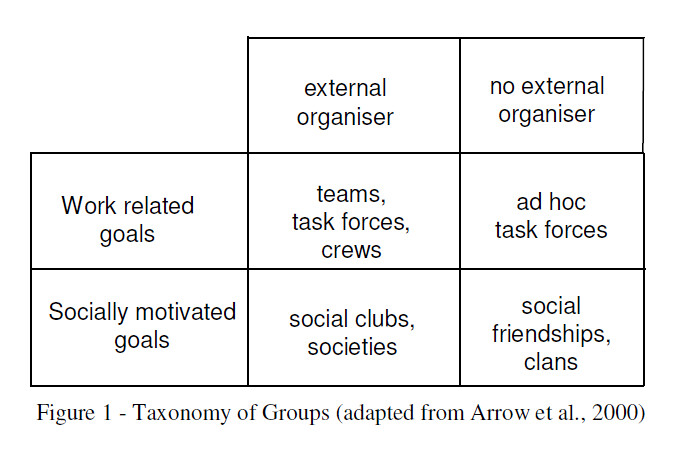This book
looks at available literature on the topic from different schools of thought and a vast array of previous researches (before 2000) on small groups,
define a new approach to the study of small groups that include new fields (general system theory, dynamical systems theory, complex systems theory) and
set the foundation for new researches.
For those like me that are looking for a
deeper understanding of groups dynamics here some interesting excerpt from the book.
The different kind of
groups formation, based on the forces that drive the group formation (internal or external) and the motivation (work goals or social goals) for the group formation:

The SGACS book describe the different characteristics and dynamics of different kind of teams. These descriptions help to understand for example where a crew work better, where a team work better and where an ad hoc task force work better.
The additional distinction (emergent or planned) of
groups formation:
The SGACS book describe different kinds of group formation, and show the difference between externally planned groups that are more common in traditional organizations and emergent internal groups that are these that have an high potential to originate self-organising teams.
The
group's model components:
Here the
conjecture about
how global dynamics emerge from local dynamics. That come from the case studies presented in the SGACS book. It should be noted that these are hypotheses, not stated explicitly in SGACS and should be validated by experimental and empirical study.
In the following table
- KSA =
knowledge, skills and abilities,
- VBA =
values, beliefs and attitudes,
- PCB =
personal, cognitive and behavior styles.
In each row there is a local dynamic and in each column how it influence a global dynamic. More on the global dynamic in this post:
Monitoring and supporting the emergence of team dynamics toward positive directions
When talking about
self-organising teams is important to remember that:
- team members can intervene directly to the local dynamics, while who manage the team can act on the boundaries, on the surrounding environment, on the fitness landscape, he/she cannot micro-manage or direct the team
See as example the ABIDE model and other useful models for self-organising teams: Coaching Self-Organizing Teams
- the team need early frequent feedback to see what are the consequences of teams actions and so self-regulate.
Without boundaries/barriers and their management, with micro-management or without self-regulation driven by feedback a self-organising team cannot find a way to influence the emergence of global dynamics toward positive directions.
This sentence explain the role of a Coach of a self-organising team.
More from the paper:
Extending Small Group Theory for Analysing Complex Systems